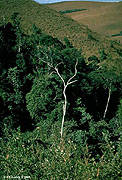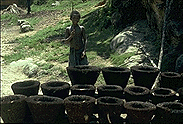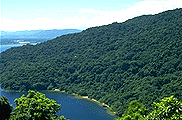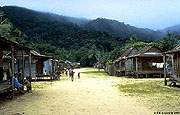 |
QUICK SEARCH
MO PROJECTS:
Africa
Asia/Pacific
Mesoamerica
North America
South America
General Taxonomy
Photo Essays
Training in Latin
America
MO RESEARCH:
Wm. L. Brown Center
Bryology
GIS
Graduate Studies
Research Experiences
for Undergraduates
Imaging Lab
Library
MBG Press
Publications
Climate Change
Catalog Fossil Plants
MO DATABASES:
W³MOST
Image Index
Rare Books
Angiosperm
Phylogeny
Res Botanica
All Databases
INFORMATION:
What's New?
People at MO
Visitor's Guide
Herbarium
Jobs & Fellowships
Symposium
Research Links
Site Map
Search
THE CLASSIFICATION OF NATURAL AND |
||||||||||||||||||||||||||||||||||
 |

|
Much of Madagascar is now covered with anthropogenic vegetation, and its extent is still expanding at an alarming rate. But even Madagascar's so-called "natural" vegetation is by no means isolated from man's influence. Large areas of forest are impacted, to one degree or another, by direct human action. For example, over-exploitation of Cyathea tree ferns is critical in many areas.
|
Ranomafana National Park 1-hectare plots |
|||
| Miaranony | Vatoharanana | Vohiparara | |
| Altitude | 600 m | 950 m | 1200 m |
| # Stems | 769 | 660 | 1092 |
| # Araliaceae | 18 (2.3%) | 18 (2.7%) | 122 (11%) |
| # Cyathea | 62 (8.1%) | 5 (0.76%) | 11 (1.0%) |
| Basal Area (m2) | 49.91 | 34.96 | 25.61 |
At Ranomafana National Park, results from 1-ha permanent plots show that tree ferns are now almost totally absent at Vatoharanana (950 m) and Vohiparara (1,200 m), where stumps indicate recent cutting. By contrast, tree ferns make up nearly 10% of the stems greater than 10 cm DBH at Miaranony (600 m), which has not been subjected to the pressures of over-exploitation -- or at least not yet.
 Nosy Mangabe Special Reserve |
 Masoala Peninsula |
Perhaps even more insidious is the kind of indirect impact humans are having. The common rat, Rattus rattus, introduced to Madagascar by seafarers, now occurs in large numbers throughout the island, even in the middle of what appears to be pristine forest (Goodman, 1995). A similar situation exists with respect to introduced ant species displacing the native ant fauna (B. L. Fisher, pers. comm.). And now, when a tree falls over in the heart of the Masoala Peninsula, in the middle of one of the country's largest remaining blocks of dense, unexplored rain forest, the opening it creates is not only colonized by native plants, but also by introduced aggressive weedy species such as the Neotropical Clidemia hirta, which was accidentally introduced in 1914 (Cabanis et al, 1970, p. 507). What kind of long-term impacts will this and other introduced species have?
The distinction between native and anthropogenic vegetation is, in reality, not as clear as one might think. Useful distinctions can be made between various levels of human impact on the vegetation, and scientific and conservation work can and should be oriented accordingly. But in the final analysis, it may well be that Madagascar -- and indeed, most of the world -- no longer really possesses any truly "natural" vegetation.
ACKNOWLEDGMENTS
We wish to thank D. Du Puy, M. H. Faramalala, B. L. Fisher, S. M. Goodman, J.-L. Guillaumet, Ph. Morat and F. Rakotondrainibe for valuable and interesting discussions. Field work in Madagascar was conducted under collaborative agreements between the Missouri Botanical Garden and the Parc Botanique et Zoologique de Tsimbazaza (PBZT) and the Département de Recherche Forestière et Piscicole (D.R.F.P., FO.FI.FA.). We gratefully acknowledge courtesies extended by the Government of Madagascar (Direction des Eaux et Forêts) and by the Association Nationale pour la Gestion des Aires Protégées (ANGAP). The Missouri Botanical Garden's Madagascar program has received support from the John D. and Catherine T. MacArthur Foundation, the Liz Claiborne and Art Ortenberg Foundation, and the National Science Foundation (DEB-9024749).
© 1995-2025 Missouri Botanical Garden, All Rights Reserved
4344 Shaw Blvd.
St. Louis, MO 63110
(314) 577-5100
Technical Support